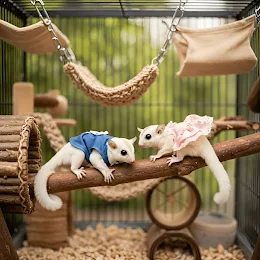The Ultimate Guide to Choosing the Perfect Sugar Glider Cage
Sugar gliders are adorable, social, and active marsupials that require a safe, spacious, and stimulating environment to thrive. Choosing the right cage is one of the most critical decisions you’ll make as a sugar glider owner. A well-designed cage ensures their physical health, mental well-being, and overall happiness.
In this comprehensive guide, we’ll cover everything you need to know about selecting the best sugar glider cage, including:
Why the Right Cage Matters
Sugar Glider Cage Requirements
Types of Cages (Pros and Cons)
Essential Cage Features
Best Cage Setup for Sugar Gliders
DIY vs. Store-Bought Cages
Cleaning and Maintenance Tips
Common Mistakes to Avoid
By the end of this article, you’ll have all the knowledge needed to provide your sugar gliders with a safe, comfortable, and enriching home.
1. Why the Right Cage Matters for Sugar Gliders
Sugar gliders are highly active, social animals that need space to glide, climb, and explore. In the wild, they live in trees and travel long distances, so captivity should mimic their natural habitat as closely as possible.
A poorly designed cage can lead to:
Stress and depression (due to lack of space or stimulation)
Obesity or muscle atrophy (from insufficient exercise)
Injuries (from unsafe materials or poor construction)
Behavioral issues (such as excessive barking or self-mutilation)
Investing in the right cage ensures your sugar gliders stay healthy, happy, and engaged.
2. Sugar Glider Cage Requirements
A. Size and Dimensions
Sugar gliders need vertical space more than horizontal space because they love to climb. The minimum recommended cage size for a pair of sugar gliders is:
24” (L) x 24” (W) x 36” (H)
Larger is always better (especially for multiple gliders).
For 3-4 sugar gliders, opt for a cage that’s at least 30” x 30” x 48” or bigger.
B. Bar Spacing
Ideal spacing: ½ inch or less
Wider gaps can lead to escapes or injuries.
C. Material
Powder-coated wrought iron or stainless steel (safe, durable, and easy to clean)
Avoid galvanized metal (zinc coating is toxic if chewed).
D. Security Features
Locking doors (sugar gliders are clever escape artists)
Secure latches (prevent accidental openings)
3. Types of Sugar Glider Cages (Pros and Cons)
A. Wire Mesh Cages
✅ Pros:
Excellent ventilation
Easy to attach toys and accessories
Durable and long-lasting
❌ Cons:
Some have sharp edges (check for safety)
Can be harder to clean if not designed well
B. Modular Cages (Stackable or Expandable)
✅ Pros:
Customizable for multiple gliders
Can add levels or extensions
❌ Cons:
More expensive
May require assembly
C. DIY Cages (Custom-Built)
✅ Pros:
Tailored to exact needs
Can be cost-effective
❌ Cons:
Requires time and skill
Must ensure all materials are safe
D. Critter Nation & Prevue Hendryx Cages (Popular Brands)
✅ Pros:
Spacious and well-designed
Easy to clean
Trusted by exotic pet owners
❌ Cons:
Higher price point
4. Essential Cage Features for Sugar Gliders
A. Multiple Levels & Platforms
Provides climbing opportunities
Use natural wood branches, ropes, and ladders
B. Sleeping Pouches & Nesting Boxes
Sugar gliders need cozy, dark spaces to sleep
Fleece pouches are ideal (easy to wash)
C. Wheels & Exercise Equipment
Silent spinner wheels (prevent tail injuries)
Avoid wire wheels (can cause injuries)
D. Food & Water Dishes
Ceramic or stainless steel bowls (chew-proof)
Water bottles (leak-proof design)
E. Toys & Enrichment
Foraging toys (stimulate natural behaviors)
Swings, tunnels, and chew toys
5. Best Cage Setup for Sugar Gliders
A. Location of the Cage
Avoid direct sunlight & drafts
Place in a quiet but social area (sugar gliders are social and enjoy interaction)
B. Bedding & Substrate
Fleece liners (easy to clean)
Paper-based bedding (avoid cedar or pine toxic fumes)
C. Temperature & Humidity Control
Ideal temp: 75-80°F (24-27°C)
Use a small space heater or ceramic heat emitter if needed
6. DIY vs. Store-Bought Cages
A. DIY Cage Options
PVC pipe cages (lightweight, customizable)
Converted bird cages (must check bar spacing)
B. Best Store-Bought Cages
Midwest Critter Nation (expandable, sturdy)
Prevue Hendryx Feisty Ferret Cage (great ventilation)
Exotic Nutrition’s Sugar Glider Cage (designed specifically for gliders)
7. Cleaning & Maintenance Tips
Daily: Remove uneaten food, clean water bowls
Weekly: Wash fleece liners, sanitize toys
Monthly: Deep-clean the entire cage
8. Common Mistakes to Avoid
❌ Choosing a cage that’s too small
❌ Using unsafe materials (toxic woods, galvanized metal)
❌ Placing the cage in a noisy or isolated area
❌ Neglecting enrichment (boredom leads to health issues)
Final Thoughts
A well-chosen sugar glider cage is the foundation of your pet’s health and happiness. By prioritizing space, safety, and enrichment, you’ll create an environment where your sugar gliders can thrive.









